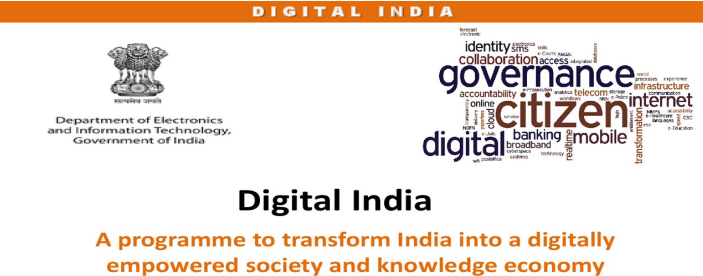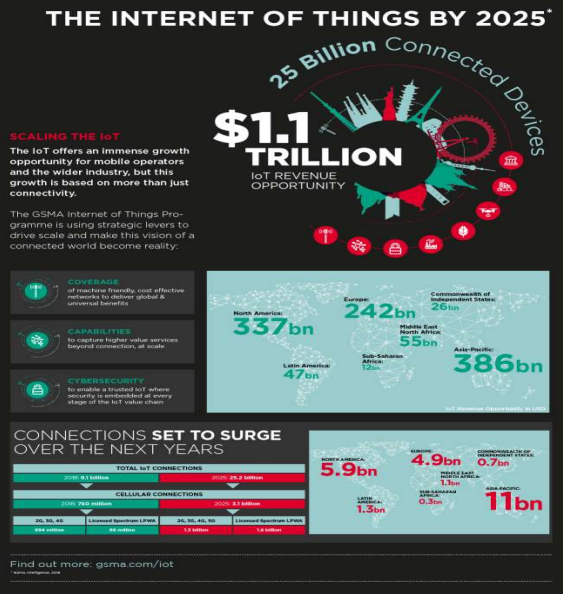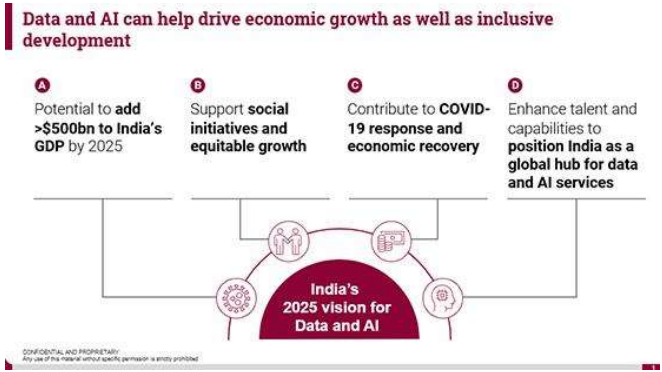Perspective
The Power of 3 – IoT, AI and Cloud – For Business and Societal Impact

The Digital India was the flagship programme of the Government of India that was launched in July 2015 with a clear vision to transform India into a Digitally empowered society and a knowledge economy. The Digital India Programme was centred on three key vision areas:
Digital Infrastructure as a Core Utility to Every Citizen in India
Governance & Services on Demand
Digital Empowerment of Citizens
The Government of India has aspirations to make India a USD 1 trillion Digital Economy by 2025 and in order to achieve this goal various initiatives are in place. The striking feature of the recent FY23 Budget proposal was its focus on growth through Infrastructure development, both Physical and Digital. For those advocating the importance of Digital Technology, it is extremely heartwarming that Digitalization now runs as one of the principal themes across many Government spending initiatives.

Since the launch of the Digital India programme on July 1, 2015, by the Prime Minister Shri Narendra Modi, we have seen significant increase in mobile broadband subscription and Data usage. India has nearly 765 million Mobile Broad band subscribers and Internet usage is now amongst the highest in the world with an approximate 17GB Data usage per month as per Nokia’s Annual Broadband Index Report 2022 . India is now ready to embark on the next phase of the Digital revolution. The path of Digital India 2.0 will no doubt encounter a series of challenges, which includes strengthening of Digital infrastructure, Upskilling & Re-skilling of our young workforce, developing India’s own Digital applications to solve real life problems in Manufacturing, Education, Healthcare, Agriculture, Energy etc.
There are a few key levers of Digital transformation that can help India hit the target of a $ 1
Trillion Digital economy which is highlighted below :
- Acceleration of IoT adoption
- Democratization of AI
- Cloud adoption driven by augmenting our Data Centre Infrastructure
Acceleration of IoT Adoption
IoT can transform India in unique ways to reach the masses where sophisticated technology may not reach, through applications such as Intelligent tracking systems in Transportation, Industrial wireless automation, Public safety and security, personal health monitoring, and health care for the aged community. India’s IoT landscape has evolved both in coverage and depth. Be it the IoT start-up ecosystem, IoT-specific patents, or IoT space, India is seeing significant growth in all these areas. As per a NASSCOM report around 5,000 IoT patents were filed from 2014-2019, and this trend is expected to continue through 2022. Increasing internet bandwidth and availability, a rise in smartphone usage and a growing number of devices with built-in sensors will drive the IoT market in India.

Democratization of AI
Artificial Intelligence ( AI ) has the potential to contribute 10% of India’s GDP by 2025; a figure conservatively pegged at US$500bn. Today, the question is not ‘if’ AI has the potential to Digitally transform the Indian economy but as to how to achieve the goals that have been envisaged. As per a NASSCOM report global AI market has expanded 45% y-o-y in 2021 and is expected to reach US$219bn by 2025. AI is already changing the way businesses operate today, from how they communicate with their customers via virtual assistants, to automating key workflows, and even managing Network and Data /Information security. Another recent IBM research revealed that more than half of CEOs expect AI to deliver tangible business benefits in the next few years.

Cloud Adoption driven by Augmenting our Data Centre Infrastructure
COVID 19 has pushed the demand for Cloud service across the world with Digital transformation initiatives being accelerated across industries, and the Internet becoming a lifeline for people both for work as well as for entertainment. This shift towards Cloud has pushed increased investments in hyper-scale Datacentres with the global Datacentre market investments expected to reach $200 billion per annum by 2025, and India is expected to account for 2.3% of these total investments. In the recent Budget, Finance Minister Nirmala Sitharaman granting infrastructure status to Data centres is expected to give a huge boost to the industry.
Cloud Adoption in India is expected to get a significant fillip with the augmentation of India’s Datacentre infrastructure as all the data and applications will be residing within the boundaries of India ensuring better latency, better performance of applications and to also comply with regulations around Data localization if the need arises.
As per a NASSCOM report, Global Public Cloud spend, valued at $332 bn (2021), is projected to grow by 20% YoY till 2022 . India’s Cloud market was estimated at $4.4 bn (2021); projected to grow 26% to reach $5.6 bn (2022) . The need for businesses to migrate critical workloads to the Cloud and modernize legacy on-premise IT infrastructure will boost growth of IaaS and PaaS . Customer Experience, Relationship Management, Content and Collaboration Services are expected to be the emerging segments of growth.
For any large Digital transformation initiative either from a large Enterprise or from the Government for citizen impact, it requires IoT, Cloud and AI technologies working together seamlessly.
Reliable, Secure and High speed Digital Connectivity is an absolute necessity to enable Digital applications and businesses to run. As the world grows more Digitally dependent, the role of Communication Service Providers ( CSPs) in achieving the Connected future will continue to evolve at a rapid pace. While Connectivity forms the core of all things Digital, CSPs must endeavor to increase their speed, agility and versatility as service providers, delivering Digital Disruptive solutions and services to customers will give them a competitive advantage. At the end of the day, connecting everything is a natural extension of the core business of Connecting people . There are a range of technologies available such as traditional Cellular (2G/3G/4G/5G), Low Power Wide Area networks like NB-IoT and LTE-M using licensed spectrum and LoRa WAN using unlicensed spectrum, Wi-Fi, Bluetooth – Short range communication and Satellite technology.
The emergence of 5G, the fifth generation of wireless mobile communications, will no doubt have a major impact on how services are delivered. It’s poised to jumpstart the next wave of mobile innovation.
The eventual 5G value proposition is best summed up as.
Latency + Security + Reliability + Speed = Better User Experience.
As these networks mature they will ultimately deliver up to 50x more speed, 10x less in end-to-end latency, and 1,000x more capacity than 4G/LTE . Businesses will gain the ability to achieve true wireless flexibility—with a consistent performance resembling wired networks. This means being able to Connect, Collect, and Create in new ways, enabling a new standard in the convergence of Cloud, Network, Data, and Applications. Businesses can use consumer-grade sensors, but business needs are typically more rigorous and demanding than consumer needs. Businesses of all sizes should turn to enterprise-grade sensors and IoT for unique device needs like Asset management trackers, Robots, and Personal Protective Equipment. The addition of this “Smart” technology can help companies gain insights into business and consumer needs in near-real time to be used to drive increased revenue, efficiencies, and productivity. Adding 5G to existing 4G network architectures, combined with other next-generation technologies such as Internet of Things (IoT) devices and Edge capabilities, enable more feature- and function-rich user experiences across the entire business. From Retail to Financial services, Transportation to Manufacturing to Healthcare, and across virtually all industries and businesses, 5G is beginning to make an impact.
As far as India is concerned, we expect 5G spectrum to be auctioned sometime in the second half of this year and with more fiberisation of towers that is needed for backhaul, we are hoping commercial launch of 5G services sometime later this year.
With high speed and secure Digital networks powering the Digital backbone, we will be able to unlock the huge value from Data that can be gleaned by Sensorization of Assets through IoT, use the Elasticity ,scale and compute and storage capacity of the Cloud to run the Applications and Platforms, and finally AI to glean the rich insights from the huge Datasets that will help in decision making and also to predict business outcomes. The Power of these 3 technologies powered by Digital communication networks working seamlessly will be able to enhance business transformation and create value for all stakeholders – Businesses, Consumers and Society at Large.
The author is Ex-Regional Director(IoT)- AT&T; Co-Chair of Digital Comm.Group of IET Future Tech Panel; NASSCOM IoT Tech Guru for W2RT; CII National AI Forum Member and CII Inst. of Logistics –Elite Member















You must be logged in to post a comment Login